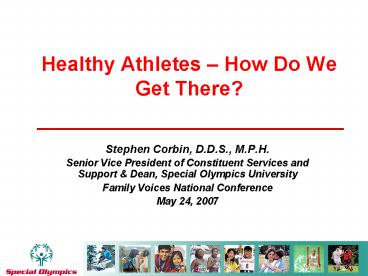Healthy Athletes How Do We Get There - PowerPoint PPT Presentation
1 / 16
Title:
Healthy Athletes How Do We Get There
Description:
... clinical services (e.g. glasses), educational information, and referrals for follow up care ... Athletes Who Needed New Glasses ... – PowerPoint PPT presentation
Number of Views:69
Avg rating:3.0/5.0
Title: Healthy Athletes How Do We Get There
1
Healthy Athletes How Do We Get There?
- Stephen Corbin, D.D.S., M.P.H.
- Senior Vice President of Constituent Services and
Support Dean, Special Olympics University - Family Voices National Conference
- May 24, 2007
2
Why Healthy Athletes?
- SOI discovered tremendous unmet health needs
- The public does not understand these needs
- Society under-invests in health of people with ID
- SOI discovered that providers are not prepared to
treat this population - Documentation of the problem has been inadequate
(science) - Athletes need essential services, education and
referral for QOL on and off the field - Public policies are deficient
3
What is Healthy Athletes?
- Became official SO program in 1997 Happy B-Day!
- Designed to help SO Athletes improve training and
competition by focusing on overall health and
fitness - Provides basic health screenings, some clinical
services (e.g. glasses), educational information,
and referrals for follow up care - Through critical health services, athletes have
enhanced sports experiences and improved
well-being - Contributes to self determination
- Impacts public policy
4
Goals of the Healthy Athletes Program
- Delivery of health care services to SO Athletes
- Referral for professional services as indicated
- Recruitment/training of health professionals in
working with persons with intellectual
disabilities - Documentation of health status/needs of Athletes
- Advancement of knowledge about effective health
care delivery to persons with intellectual
disabilities - Advocacy for improved public policy in support of
health needs of persons with intellectual
disabilities
5
Opening Eyes - Screenings
Self Reported Last Eye Exam All Athletes
percent ()
Time Since Last Exam Data from Special Olympics
World Games in Dublin in 2003 Nagano in 2005
6
Opening Eyes Screenings (By Age)
Athletes Who Needed New Glasses
Athletes Who Did Not Pass the Vision Screening
percent ()
percent ()
Age
Age
Data from Special Olympics World Games in Dublin
in 2003 Nagano in 2005
7
Healthy Hearing Screenings (By Age)
Athletes Who Did Not Pass the First Level of
Hearing Screening
Athletes Who Did Not Pass Second Level of Hearing
Screenings
percent ()
Age
percent ()
Age
Data from Special Olympics World Games in Dublin
in 2003 Nagano in 2005
8
Fit Feet - Screenings
Foot and Nail Conditions
percent ()
Age
All Athletes
percent ()
Data from Special Olympics World Games in Dublin
in 2003 Nagano in 2005
All Ages
9
Special Smiles - Screenings
Treatment Urgency
By Age
All Athletes
percent ()
percent ()
All Ages
Data from Special Olympics World Games in Dublin
in 2003 Nagano in 2005
10
Screening Findings
- Of Special Olympics athletes (n5447 average age
24 years) volunteering to participate in the
Special Smiles Program in the United States - Some 12 report pain in their mouths at the time
of the screening - More than a third have obvious signs of gingival
(gum) infection - Nearly a fourth have obvious dental decay
(without probing or x-rays) - One quarter are missing teeth, reflecting
end-stage treatment of common dental diseases - Too many have extensive dental plaque that leads
to infection of oral tissues, hard and soft, and
ultimately, loss of teeth - And, too many athletes and families report that
they have never been able to secure a regular
source of dental care for their child, even as
nearly one in ten are in need of urgent dental
care.
11
Testimony Before Congress
- US Senate Appropriations Committee July 2006
- US House of Representatives Health Sub-Committee
April 2007 - Importance of safety net dental care programs
- People with ID are medically underserved
- Providers are not prepared
- Funding is not market rational
- Age 21 cut off for comprehensive dental services
is both illogical and unfair
12
Publics Beliefs about the Quality of Health Care
Received by Individuals with Intellectual
Disabilities
percent ()
13
Educating Medical Professionals
- Eighty-one percent of medical school students say
they are not getting any clinical training
regarding individuals with intellectual
disabilities and two-thirds (66 percent) are not
receiving enough classroom instruction. - Fifty-two percent of medical school deans, 53
percent of dental school deans, 56 percent of
students and 32 percent of medical residency
program directors responded that graduates were
not competent to treat people with intellectual
disabilities. - Fifty-eight percent of medical school deans and
50 percent of dental school deans say that
clinical training regarding individuals with
intellectual disabilities is not a high priority.
Most medical school deans (81 percent) cite lack
of curriculum time as the primary reason for not
training students in a more specialized way.
14
How Are We Doing?
- More than 55,000 health professionals and health
professions students volunteered between
1999-2006 - Screenings for 500,000 athletes conducted at
2,200 events over 10 years 642 now conducted
annually - Trained hundreds of volunteer Clinical Directors
in 80 countries and all 50 states, and nearly
13,000 volunteer health professionals annually - Now a 20 million annual program
- Provider Directory
Healthy Athlete Events 1997-2006
15
Making an Impact
- James Pierce
Before After
16
Healthy Athletes Disciplines
- Fit Feet
- FUNfitness
- Health Promotion
- Healthy Hearing
- MedFest
- Opening Eyes
- Special Smiles






























![[PDF] DOWNLOAD The Foot Strength Plan: Healthy Feet, the Tru PowerPoint PPT Presentation](https://s3.amazonaws.com/images.powershow.com/10084458.th0.jpg?_=202407240311)
